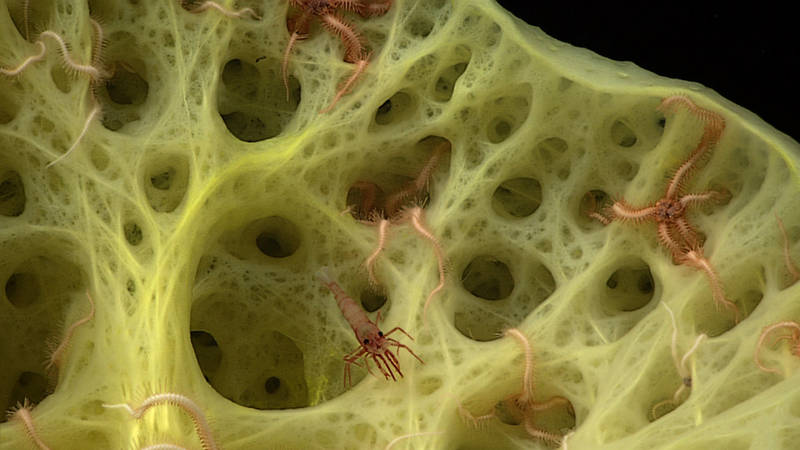
Large stalked sponge (Bolosoma sp.) providing a home for a myriad of brittlestars and crustacean associates. Image courtesy of the NOAA Office of Ocean Exploration and Research, 2015 Hohonu Moana. Download larger version (jpg. 1.2 MB).

Large stalked sponge (Bolosoma sp.) providing a home for a myriad of brittlestars and crustacean associates. Image courtesy of the NOAA Office of Ocean Exploration and Research, 2015 Hohonu Moana. Download larger version (jpg. 1.2 MB).
Dive 08 of the expedition was conducted today on a seamount on the south side of Bank 9, located about 50 nautical miles south of Pearl and Hermes Atoll. Previous high-resolution mapping data of Bank 9 suggests that it is a composite feature that includes both a Cretaceous guyot (flat-topped seamount) to the south as well as a younger Hawaiian guyot to the north. The objectives of the dive were to explore for high-density communities of deep-sea corals and sponges and look for clues on how this peculiar composite seamount might have formed. The dive started at 1,380 meters on a sloped surface of pavement mixed with rubble, heavily encrusted with manganese (Mn) and hosting a bamboo coral and a chrysogorgid coral. As the ROV moved up the slope towards the terrace of the seamount, the density of animals remained very low and included corals, sponges, asteroids, crinoids, sea pens, urchins, shrimps, fishes, and sea cucumbers. On the terrace of the seamount, the substrate changed to Mn-coated cobbles and the density of animals continued to remain low. As the ROV reached and moved up the slope of the cone, several colonies of scleractinian corals (Enallopsammia rostrata), bubble gum corals and sponges (Atlantisella sp.) appeared; however, the density of animals remained low. On the summit there were several pillow lavas in parallel rows and very few animals. The ROV left the bottom at a depth of 1,096 meters after a total bottom time of six hours and 52 minutes.